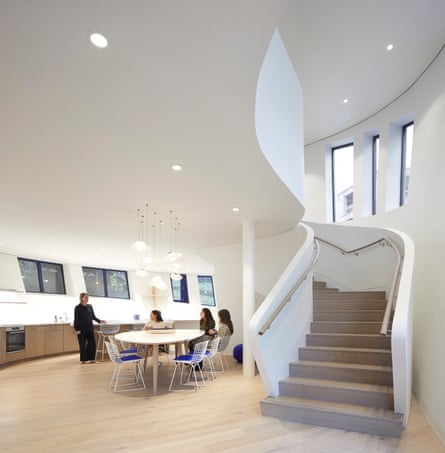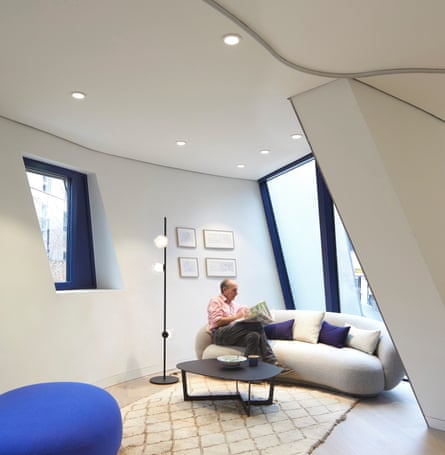How important is the form of a building? How much can the impression it makes on your retina move you, alienate you, create beauty or identity? On the face of it, quite a lot, and it is most of what you see when buildings are published in history books or newspapers or in snapshots in social media culture wars that pit traditional against modern buildings. But in the lived experience of architecture, other qualities are at least as important: how they work, materials and surfaces, the fall of natural and artificial light, detail and craft, scale, acoustics, the relationships of buildings to their human-made and natural surroundings, and to the lives that go on in and around them. Take the difference between a plastic souvenir of the Taj Mahal and the real thing – they are unalike in every way except shape.
This question is prompted by the latest Maggie’s cancer centre at the Royal Free hospital in Hampstead, north London. Its design, by the New York-based Daniel Libeskind, is not exclusively about shape, but that’s what hits you when you see it. It’s a building of undulating, outward-splaying walls punctuated by windows in the shape of scalene quadrilaterals, with a sinuous stair rising through its intentionally fragmented interior. Its finishes, next to the extravagant extraordinariness of the forms, are humdrum: engineered timber cladding on a steel frame, light grey oak floors and white-painted plasterboard inside. An earlier and promising-looking all-timber design was rejected – not for cost reasons, insists Maggie’s, but because its wooden bars looked “too prison-like”.
Maggie’s centres, of which there are now 24 attached to hospitals all over the UK, have two main aims. They provide support to patients and their loved ones – such things as counselling, practical advice, companionship, physical activity – that complements medical cancer treatment. They seek to do this in architectural environments that raise the spirits, engender relaxation and peace; that are antidotes to the mechanised, medicalised interiors, all plasticky surfaces and deadening lighting, that you tend to get in hospitals. This ambition is easy to understand. It’s harder to know exactly what qualities you want from the architects tasked to achieve it.

The centres were invented by the garden designer Maggie Keswick, who died of cancer in 1995, and her husband, Charles Jencks, the architectural critic and theorist who put the idea into action. He got the biggest names in architecture, most of whom were also personal friends – Frank Gehry, Zaha Hadid, Norman Foster, Rem Koolhaas – to design the centres, reducing their fees in the process. Libeskind, who made his name with the Jewish Museum in Berlin, which opened in 2001, was very much part of Jencks’s circle of famous architects. They were all, to use a word they mostly disliked, but which Jencks himself embraced, “iconic”.
Libeskind’s architecture is one of complex and irregular shapes, driven by a wish to find the ways in which buildings may carry meanings about human life. “I’ve always been allergic to purism and to purity,” he says. “Life is complex.” His design for the Jewish Museum attempted with a jagged plan and inscrutable patterns to embody the ways in which Jewish culture and Berlin’s history were enmeshed, as well as their violent rupture under the Nazis. Such interactions of form and meaning were dear to Jencks, who died in 2019. Libeskind was one of the first architects he approached to design a centre, but two previous projects in other locations for various reasons didn’t work out, which is why it has taken so long.

The current location is a car park, hidden from view from of the street, but Libeskind saw this unpromising setting, he says, as an opportunity to make “an affirmation of life, of beauty, wherever you are”, a “medieval modernist” building that is “totally handcrafted and not repetitive in any way, the most nonrepetitive building in the world”. It’s “a building as organic as the people in it”, one of “faith and belief”, that encourages its users to feel “that you will be better, that you’re not alone”. Its design was “a labour of love”. With the time that his office put into this one building, they could have designed “20 mindless boxes”.
And so there stands a three-storey structure that, next to the industrial-scaled, straight-lined behemoth that is the Royal Free hospital’s main building, strives to be intricate and intimate. On the ground floor is a big kitchen, a feature of all Maggie’s, where anyone who likes can linger around a large table. A wandering route takes you upwards, past open-plan balconies and alcoves for resting or chatting to a top-floor sitting room connected to external terraces. More secluded rooms for private conversations, and spaces for exercise and group activity open off this route.

At its best, the design offers ever-shifting views up, across and out of the building, an intriguing three-dimensional collage of the vertical interior with its multilevelled surroundings – there’s a slope in the ground, a bank to one side, and the hospital towering overhead. You get glimpses of tree or sky, or of the surrounding buildings broken up by those wonky windows, or of other parts of the centre. The interior also has the quiet conviviality common to all the Maggie’s centres that I have seen, made by the spirit of the institution and its people as much as by the architecture.
A few grumbles could be heard from some early users of the building. They don’t like the way that sound bounces from one part of the open interior to another, something that can hopefully be improved when more soft furnishings are installed, or the awkwardness of holding a yoga class in a nonrectangular room. “It’s like one of those art galleries – you know, the Guggenheim,” said one, which may or may not be a compliment. “It’s like an airport,” said another, which wasn’t.

The point of the building, say its makers, is not to be purely functional. “You will never go here and have a dull thought, ever,” claims Libeskind. “It’s good if the architecture gives people something to think about,” says Laura Lee, chief executive of Maggie’s. I’d share their resistance to dull uniformity, and appreciate the creative ambition of their work. But there’s a point at which the relentless singularity of the shapes becomes its own kind of boring, excluding other qualities. The life of the building then takes place despite, rather than because of, the design. It’s a style that has trouble coming back to earth: when the unavoidable rectangularity of a door or a hanging curtain interposes, the play of slants and curves judders to an awkward halt.
Maggie’s choice of architects has evolved over the years towards slightly less stellar practices, whose projects delight the senses more with simpler forms and spaces, as dRMM did in Oldham and Amanda Levete Architects in Southampton. This is progress – architects globally feted for the signature style that they bring to museums and skyscrapers and airports are not necessarily best suited to the more subtle qualities of a cancer centre. The Royal Free is, or should be, the last of the Maggie’s icons.

Comments (…)
Sign in or create your Guardian account to join the discussion